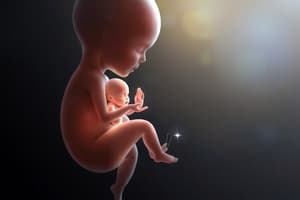Podcast
Questions and Answers
What is the primary outcome of fertilization?
What is the primary outcome of fertilization?
- Formation of a blastocyst
- Creation of a diploid zygote (correct)
- Development of the placenta
- Transport to the uterus
Which type of cell forms the embryo during the blastocyst stage?
Which type of cell forms the embryo during the blastocyst stage?
- Mesoderm
- Ectoderm
- Trophoblast
- Embryonic disk (correct)
What process occurs during the embryonic period that leads to the formation of tissues and organs?
What process occurs during the embryonic period that leads to the formation of tissues and organs?
- Fertilization
- Organogenesis (correct)
- Implantation
- Neurulation
What is the significance of the trophoblast cells during the germinal period?
What is the significance of the trophoblast cells during the germinal period?
Which layer of cells is responsible for forming the skin and nervous system?
Which layer of cells is responsible for forming the skin and nervous system?
What happens at the end of the germinal stage?
What happens at the end of the germinal stage?
What percentage of conceptions typically continue development after the first two weeks?
What percentage of conceptions typically continue development after the first two weeks?
Which structure provides nutrients and oxygen to the developing embryo?
Which structure provides nutrients and oxygen to the developing embryo?
Flashcards
Germinal Period
Germinal Period
The first two weeks of prenatal development, starting with conception and ending with implantation in the uterine wall.
Fertilization
Fertilization
The process of a sperm cell fertilizing an egg cell, creating a single cell with the combined genetic material of both parents.
Zygote
Zygote
The single cell formed after fertilization, containing the complete genetic makeup for a new organism.
Blastocyst
Blastocyst
Signup and view all the flashcards
Trophoblast
Trophoblast
Signup and view all the flashcards
Placenta
Placenta
Signup and view all the flashcards
Embryonic Period
Embryonic Period
Signup and view all the flashcards
Neuroectoderm
Neuroectoderm
Signup and view all the flashcards
Study Notes
Germinal Period
- The germinal period spans approximately 14 days, from conception to implantation.
- Fertilization, typically in the fallopian tube, creates a zygote—a new diploid cell containing combined genetic material from both parents.
- The zygote divides, traveling down the fallopian tube.
- A 100-cell blastocyst forms after five days of division.
- The blastocyst comprises two key cell groups:
- The inner cell mass (embryonic disk) develops into the embryo.
- The trophoblast forms the placenta.
- Trophoblast cells invade the uterine wall, establishing a connection with the mother's circulatory system.
- The placenta, connected to the uterus, supplies nutrients and oxygen to the embryo via the umbilical cord.
- Implantation marks the end of the germinal stage.
- Roughly half of all conceptions do not develop past the first two weeks.
Embryonic Period
- Implantation transforms the blastocyst into an embryo.
- During the embryonic period, cells differentiate and specialize.
- Organogenesis, the development of tissues and organs, occurs through three germ layers.
- These germ layers remain throughout a person's life:
- Ectoderm: Forms skin, sensory organs, and the nervous system, including the neuroectoderm responsible for the nervous system.
- Mesoderm: Gives rise to the circulatory system, lymphatic system, bones, muscles, and many internal organs (kidneys, spleen, gonads, etc.).
- Endoderm: Develops into the organs of the gastrointestinal and respiratory systems, and structures like the thymus, bladder, and urethra.
- By the end of week eight, the embryo is about 1 inch long and weighs roughly 8 grams.
Studying That Suits You
Use AI to generate personalized quizzes and flashcards to suit your learning preferences.
Description
Explore the crucial early stages of human development in this quiz focusing on the germinal and embryonic periods. Understand the processes from conception to implantation and how the embryo is formed and nourished. Test your knowledge on key concepts such as zygote formation, implantation, and the role of the placenta.



